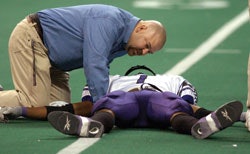Heightened awareness of concussions is changing the culture of prep sports.
 Photo of a football player lying on the turf
Photo of a football player lying on the turfTwo months after Washington state enacted the toughest concussion law in the country - one that requires young athletes suspected of having sustained a concussion to receive medical clearance before returning to action - a 14-year-old freshman football player at Duvall's Cedarcrest High School was overpowered by an opponent, knocked backward and landed on his head. The boy was airlifted to a medical center in nearby Seattle, diagnosed with a severe concussion and released the next day. "If he does come back and play this year, that will be up to the doctors," Jason Frederick, Cedarcrest's athletic director and head varsity football coach, told Everett's Daily Herald.
"The law did what it is supposed to do, which is prevent preventable brain injuries," says Richard Adler, founding principal at Seattle-based law firm Adler Giersch P.S., who as president of the Brain Injury Association of Washington helped draft Washington's Zackery Lystedt Law. "The kid in Cedarcrest had a concussion, they took him out, and they didn't put him back in until he could be cleared properly."
The Lystedt Law (which unanimously passed both the Washington House and Senate) has influenced similar legislation in other states and kick-started efforts to establish federal regulations regarding concussion management. It stipulates that only licensed healthcare providers can make return-to-play decisions and that they be trained in the evaluation and management of concussions. So far, medical doctors, osteopaths, physician's assistants, nurse practitioners and certified athletic trainers have been approved to make those decisions. The law also mandates that school districts work with the Washington Interscholastic Activities Association to educate coaches, players and parents about the nature and risk of concussions, and stipulates that student-athletes and their parents sign an information sheet about concussions and head injuries prior to each season. Youth sports associations that use publicly owned fields also must comply with the law.
Zackery Lystedt was 16 when he suffered a concussion near the end of the first half of an October 2006 football game. He was removed from the game but returned for the first play of the third quarter and played a significant portion of the second half. At the end of the game, he collapsed on the field, and his brain hemorrhaged. In a coma for more than a month as a result of the cumulative impacts his head and brain endured, he remains paralyzed on his right side and confined to a wheelchair. "People weren't taking concussions seriously," says Adler, who now chairs the Brain Injury Association of Washington's executive board. "But now they're realizing there's a lot more to this type of injury."
The U.S. Centers for Disease Control and Prevention estimates that more than 3.5 million sports-related concussions occur each year in the United States. Concussions were the second most common injury among high school student-athletes during the 2008-09 school year (behind ankle strains and sprains), according to the National High School Sports-Related Injury Surveillance Study, overseen by the Center for Injury Research and Policy at Nationwide Children's Hospital in Columbus, Ohio. Researchers there estimate that high school student-athletes suffered almost 400,000 concussions between 2005 and 2008. The majority of those injuries were in football, followed by girls' soccer, boys' soccer, girls' basketball and wrestling. An alarming 16 percent of all football players who sustained a concussion severe enough to cause loss of consciousness returned to play the same day.
"This is an incredibly complex injury," says Steven Broglio, a professor in the Department of Kinesiology and Community Health at the University of Illinois and a certified athletic trainer at Unity High School in nearby Tolono. "Not every injury is going to be the same, and every kid responds differently. The first five weeks of the season, we had four or five concussions. One kid would take a nothing hit and be out for a week, and another kid would get laid out hard and be fine by Monday. I don't get it. I've got to figure it out."
To that end, Broglio spearheaded a study published recently in the National Athletic Trainers' Association's Journal of Athletic Training that indicates prep football players undergo greater head acceleration backward after impact than college football players do - potentially resulting not only in concussions but serious cervical spine injuries. On average, college athletes weigh 33 pounds more than high school athletes, but they stand only 1.2 inches taller - suggesting collegians have a more developed musculature that is better able to control head motion after impact. "The number of injuries occurring during high school football, where the disparity in medical coverage is the greatest, drives the need for a better understanding of head impacts among youth athletes," says Broglio, who used as his subjects Unity High's football players - each equipped with a head impact monitoring system encoder placed inside the helmet.
Broglio found that at the college level, blows to the front of the helmet are 10 percent less frequent and result in less force than at the high school level. Conversely, impacts to the top and back of the helmet in college occur more frequently, but with less force. "This finding highlights the need for coaching proper tackling techniques, such that the athlete keeps his head up and avoids contact with the top of the helmet," Broglio says, adding that his research also is helping helmet manufacturers enhance designs and increase layers of protection.
Diagnosing a concussion isn't as seemingly clear-cut as it once was. "Ten years ago, we used to think that you had to be knocked out to have a concussion," Broglio says. "Now we know that loss of consciousness happens only about 10 percent of the time, and it's also not a predictor of outcomes. The idea of 'I got my bell rung' has become very antiquated. Even scarier is that people know they have a concussion but don't tell anybody, because they don't want to be removed from play or be perceived as weak. They're just trying to suppress the situation, but they're putting themselves at risk."
Christopher Nowinski, a former Harvard University football player and professional wrestler with World Wrestling Entertainment, suffered multiple concussions that were never diagnosed - including a WWE career-ending blow in 2003. He would experience frequent blackouts and episodes in which he saw the sky as orange. "I thought that came with the territory," says Nowinski. "If I could walk, I could play."
Nowinski wound up seeing seven doctors before renowned neurosurgeon Robert Cantu diagnosed him with post-concussion syndrome - lingering effects of brain trauma that include headaches, memory problems, sleeping disorders and fatigue. Nowinski says he spent five years with chronic headaches and regularly sleepwalked for four. "It kind of blew my mind that I was 24 and a Harvard grad, and I didn't understand that the repetitive injuries were cumulative. Had I known that, it could have changed my outcome."
Nowinski and Cantu founded the nonprofit Sports Legacy Institute at Boston University's School of Medicine in 2007 to provide education, treatment and research regarding concussions and other brain injuries in athletes and military veterans. The institute's work involves post-mortem analysis of the brain tissue of former football players, boxers and other athletes, and has revealed that repetitive brain injuries (both concussions and non-concussive blows) can lead to a neurodegenerative disease known as chronic traumatic encephalopathy. SLI operates the Center for the Study of Traumatic Encephalopathy at Boston University.
 LEGISLATIVE IMPACT Washington Gov. Christine Gregoire signs the Zackery Lystedt Law, the country's first concussion legislation. To her left is Lystedt, who re-entered a high school football game after suffering a concussion in 2006 and remains partially paralyzed.
LEGISLATIVE IMPACT Washington Gov. Christine Gregoire signs the Zackery Lystedt Law, the country's first concussion legislation. To her left is Lystedt, who re-entered a high school football game after suffering a concussion in 2006 and remains partially paralyzed.Could young athletes who take repeated hits to the head develop CTE? "We're just on the forefront of figuring out what is happening, let alone who it's happening to," Broglio says. "The only way we're going to figure that out is if we do a 50-year longitudinal study, where we take a couple thousand high school kids and track them to see what happens. It's going to take some time; it's not anything we can solve overnight."
But Nowinski wants action taken now. As one of 16 individuals who testified at a U.S. House Judiciary Committee hearing in late October on football-related brain injuries and how the National Football League has handled the issue, he presented a sweeping "10 Point Plan to Save Football." In it, he proposed "paths to a safer game that can and should be used to reduce brain trauma" at all levels of play - including re-evaluating practices, tackling and blocking techniques, rules and rules enforcement, and the role of referees; mandating brain trauma and concussion education for coaches, certified athletic trainers, parents and athletes; and developing better methods of concussion detection, diagnosis and management.
Says Nowinski, who wrote the 2006 book Head Games: Football's Concussion Crisis, "The idea that we'll strap a helmet on a kid and tell him to run into his buddies 1,000 times - and not tell anybody on the field what the huge consequences can be - is barbaric."
The National Federation of State High School Associations was not invited to participate in the NFL congressional hearings - a snub that does not sit well with Bob Colgate, an assistant NFHS director who also oversees that organization's Sports Medicine Advisory Committee. "It makes it look like, on our end, we're not doing anything, and that's not the case," he says.
Indeed, the federation is in the process of standardizing its rules on concussion management across all sports with language that somewhat mirrors that of the Lystedt Law - although the definition of an appropriate healthcare professional will be left up to state legislatures or member state associations. Additionally, concussions are addressed in the federation's "Fundamentals of Coaching" and "First Aid for Coaches" online courses, and a 20- to 30-minute course specifically tackling return-to-play issues is expected to be available in 2010. Also, helmets made by Xenith that are designed to adapt to varying levels of impact, energy and direction through an innovative head protection system now comply with NFHS football equipment standards. "We can't mandate anything," Colgate says. "But we're trying to give as much guidance as we can based on the latest medical research on concussions."
So is NATA, which partnered with the National Academy of Neuropsychology in September to produce a 12-minute educational video called "Concussions in Hockey: Signs, Symptoms and Playing Safe." Sponsored by the National Hockey League and the NHL Players' Association, the free video boasts input from current and former players and is available at www.nata.org. A similar video for football should be ready in time for the Super Bowl. (SLI and Xenith are preparing an online training program, specifically targeting football coaches, for a spring release.)
More high schools also are using the 30-minute computerized ImPACT program, which stands for Immediate Post-concussion Assessment and Cognitive Testing. It measures attention, memory, processing speed and reaction time. The initial test establishes a baseline; if a student-athlete receives a head injury during the season, he or she retakes the test, and the results are compared. The same software is being used by several professional sports leagues.
Lawmakers in Oregon and Texas have joined Washington in mandating better concussion training and medical services, and similar legislation is pending in other states, including California and Massachusetts. In North Carolina, a task force is lobbying for mandated full-time certified athletic trainers at the state's 381 public high schools, as well as the development of a statewide concussion protocol and the establishment of team physicians who will consult with certified athletic trainers on return-to-play decisions. (According to NATA, only 42 percent of high schools in the United States have access to certified athletic trainers.)
At least two North Carolina high school football players died from brain-related injuries in 2008. Their deaths, along with the state task force's efforts, have convinced some schools previously without full-time certified athletic trainers to hire some, according to Kevin Guskiewicz, chair of the University of North Carolina's Department of Exercise and Sports Science and director of UNC's newly christened Matthew Alan Gfeller Sport-Related Traumatic Brain Injury Research Center, named after one of the prep athletes who died last year. The North Carolina High School Athletic Association also now requires any athlete with concussion-like symptoms to be cleared by a physician before being allowed to return to play.
"The best advice I can give is to have appropriate medical personnel in place," says Guskiewicz, also a certified athletic trainer who wrote the NATA's 2004 position statement on the management of sports-related concussions and is helping lead North Carolina's legislative charge. "Trust me, this is not self-serving; it's just what we know. If you have a certified athletic trainer who understands the signs and symptoms, that person can help the team - from the coaches to the players to the parents - better understand brain trauma. If you can't have that, then you might want to give strong consideration as to whether or not your school should offer contact sports."
It's clear that school districts, athletic directors, coaches, athletes and parents must adopt the medical community's mantra, "If in doubt, sit them out," when it comes to concussion management. Whether heeding that message will require a federal mandate remains to be seen. But Adler, the Seattle attorney who has dedicated his practice to individuals with traumatic brain injuries, is developing a coalition to support national legislation and predicts that if only one elected official in Washington, D.C., puts his or her weight behind the issue, a proposal could move fast.
"I'm very confident that we've got the right message at the right time," he says. "We're at a tipping point, and there's every reason to believe that the Zackery Lystedt Law will have legs, and it will walk into every other state. I want to meet the person who's opposed to putting a law like this on the books. It would make no sense to oppose it. It saves kids' lives and it makes sports safer. It's that simple."




































